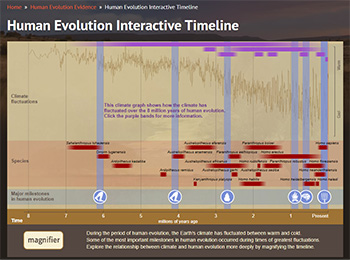Hominin Evolution
Hominids evolved in Africa. In terms of species survival, the longest existing hominids were the australopithecines (“southern apes”), living from about 4.4 Ma to 1 Ma in East and South Africa. There were two branches: the robust australopithecines, genus Paranthropus (P. aethiopicus, P. robustus, P. boisei) and, the gracile australopithecines, genus Australopithecus (A. anamensis, A. afarensis, A. africanus). The robust australopithecines had large broad cheek and jaw bones with enormous, thick enameled molars – all adaptations for crushing and grinding tough fibrous plant material. Given the publicity surrounding the fossil skeleton called Lucy, Australopithecus afarensis is the best-known species of the gracile australotpithecines. She and her kind lived some 3.2 Ma in the Afar region of Ethiopia. Her skeletal adaptations, along with the Laetoli footprints, indicate that A. afarensis walked upright.
In paleontology, although there is some chronological overlap of species, the end of the australopithecines has historically marked both a transition to the genus Homo and to the use of stone tools. The earliest types of stone tools were mostly of utilitarian Oldewan technology and were used for bashing bones to scavenge bone marrow. The species most often associated with Oldowan stone tool use is Homo habilis. But evidence of tool use now dates to 3.3 Ma and the australopithecines. Tools have been found in association with transitional species like A. sediba and A. ghari, suggesting they, or even an earlier species called Kenyanthropus platyops, were the first to use stone tools.
Designation of the genus Homo indicates when our human ancestors became truly efficient (specialized) at bipedalism. It also designates an expansion of the volume of the cranial cavity to a range between 600cc to 1300cc. The large-brained Homo who remained in Africa are sometimes called Homo ergaster, but they are more generally classified with those that left Africa for the first time around 2 Ma, called Homo erectus. Those that remained in Africa, along with the Dmanisi community in Transcaucasia (the first to migrate out of Africa some 1.7-1.5 Ma), developed a more innovative stone tool technology called Acheulean technology. These tools are symmetrical, tear-drop shaped multipurpose tools, and provide evidence of the first true hunters. In addition, there is some evidence of fire usage among Homo ergaster populations in Kenya from about 1.5 Ma.
Around 700 Ka, Homo ergaster may have evolved into Homo heidelbergensis. Some members of this species moved out of Africa too. It is suspected that they became isolated in Europe and evolved about 400 Ka into Neanderthals —an "other" type of human that was cold-adapted and bigger-brained, and who almost-exclusively hunted large animals with a new tool technology called Mousterian technology. Alternatively, Neanderthals might have evolved from groups of H. erectus who left Africa earlier, became isolated in Europe, evolved into Homo antecessor, and later mated with H. heidelbergensis groups that spread out of Africa and into Europe.
The Mousterian tools used by Neanderthals were innovative because of their single, consistent manufacture process called the Levallois technique. This technique utilized a rock core that was rotated by hand 360° as flakes were removed to leave an upraised platform that detached to form a single flake. That flake was further reshaped, by gnawing or knapping the edges. Consistent manufacture would have allowed the technique to be easily taught. It was a wasteful process, as a single core only produced one usable flake. It is possible that Neanderthals became “stuck in their ways,” only rigidly adapting when environmental or social conditions eventually changed. Their tool technology was not as efficient or specialized as the Blade technology created by anatomically modern Homo sapiens in Africa that replaced it. These anatomically modern humans (AMH), of which we are all most closely descended, evolved in Africa around 300 Ka. A catastrophe between 120 Ka and 70 Ka, caused a genetic bottleneck in the AMH population.
Shortly after this genetic bottleneck event, AMH began to spread out of Africa rapidly and extensively. They may have taken with them the knowledge of ocean tides and the passage of time, findings which appear to have originated at South African sites such as Klasies River 120 Ka. The processing of ochre into red paint is also knowledge modern humans acquired in South Africa based on archaeological evidence dating back to 100 Ka to 70 Ka at Blombos Cave. The knowledge demonstrated in these South African coastal sites represents part of the intellectual abilities modern humans carried with them as they spread throughout the world.
Although AMH had already spread into the Middle East as early as 120 Ka, more recent pioneers may have directly crossed the Red Sea by water to reach Saudi Arabia by 106 Ka. AMH reached India some 71 Ka, and spread throughout Asia, coming into contact and breeding with Denisovans (another ancient population most closely related to Neanderthals, and who appeared in isolated locations in Asia at similar times as Neanderthals in Europe). AMH continued down into Southeast Asia and across the Wallace Line, which separates all other Southeast Asian land animals from Australian land animals by miles of strong-current ocean water. Many human migrants must have made this migration, providing the oldest inference that humans developed some form of watercraft to reach the continent around 60 Ka.
Anatomically modern humans also spread into Europe around 45 Ka, where they encountered Neanderthals and interbred with them. Evidence for this includes a) Neanderthals and AMH both used mammoth bones to construct shelters and huts in some of the colder regions such as Dolni Vestonice; and b) 1-2% of Neanderthal DNA is found in some modern human populations.
Finally, humans found their way into the Americas as early as 30 Ka, although clearer evidence of human habitation in the form of footprints in White Sands, New Mexico currently dates to about 21 Ka.
Timeline
View an image of the timeline for hominin species in MCC’s Hall of Human Origins. The range bars on the map are estimates. They represent ranges based on dated fossil specimens and/or molecular genetic analysis. The timeline of hominin evolution is always in flux. As new fossils are discovered dates may be reevaluated and/or modified. Illustrated with John Gurche reconstructions.
Below is a link to the Smithsonian National Museum of Natural History’s Human Evolution Interactive Timeline which correlates major fluctuations in Earth’s climate with hominin evolutionary milestones and provides geographic species distributions along with species descriptions.
Bipedalism
By the end of the Miocene, some 6 million years ago, the ancestors of all 5 extant apes (gibbons, orangutans, gorillas, chimpanzees, and humans) had already diverged into their distinct ancestral branches of the “ape” evolutionary tree. Only one branch—the subtribe Hominina, that of humans and our fossil ancestors—evolved bipedal locomotion, the ability to walk exclusively on their hindlimbs. Although other apes, monkeys, and lemurs sometimes move on their hindlimbs alone, none of them can sustain this form of locomotion. Hominina (humans) are the only bipedal primates!
Skeletal Adaptations for Bipedalism
- Skull
The foramen magnum (in Latin “hole big”) must be centered in the middle of the floor of the cranium to allow the skull to balance directly above the body on a centered gravitational line. The spinal cord exits the cranial cavity through the foramen magnum moving down through the vertically positioned vertebral canal. In quadrupeds the foramen magnum is positioned towards the rear of the base of the skull to allow the spinal cord to pass through a horizontally positioned vertebral canal.
- Vertebral Column
The bipedal spine, or vertebral column, has an anterior-posterior S-shaped curvature which helps offset and disperse the jarring forces of foot-to-ground impact. Vertebral bodies are also modified. Large lumbar (lower back) vertebrae, which experience most of the stress, have thick, dense bodies to help absorb compressive forces and prevent fractures. Nonetheless, as we age, most of us pay the price for bipedalism with chronic lower back pain!
- Pelvis
The pelvis of a biped is broader in structure with a narrower pelvic inlet than that of a quadruped. These features help with weight distribution and with the support of internal abdominal organs.
- Legs
As our early ancestors became more comfortable on their feet, their arm length shortened relative to their legs. Unlike other living primates, anatomically modern humans primarily swing their arms for balance as they walk, rather than using them for knuckle-walking or for swinging from tree branch to tree branch (a process called brachiation).
- Hip Joint
The hip joint (the articulation between the head of the femur, or thigh bone, and the pelvis) is modified for a bipedal gait. The acetabulum, or pelvic socket, into which the femur head sits, is sturdier too and is oriented at an angle, forcing the femur inward towards the body’s midline for greater stability during locomotion.
- Knee Joint
The knee joint (the articulation between the distal end of the femur and the proximal end of the tibia, or shin bone) has also been modified for bipedalism. The shaft of the femur enters the knee joint at an acute angle – this is known as a valgus knee. The valgus knee functions significantly better in terms of energy efficiency and balance during walking or running. Australopithecus afarensis had valgus knees.
The lateral condyle (a rounded bump at the distal end of the femur) is enlarged and broadened, creating a more substantial foundation with the tibia, and allowing it to cope as a major point of stress for the body’s shifting weight. In Hominina, the modified concave proximal condyles of the tibia with the patella (kneecap) create a locking mechanism for the knee joint preventing it from sliding forward. Therefore, the knee can straighten completely in an upright position to stabilize stance. By contrast, the knees of other primates always remain at least slightly bent.
- Foot
Unlike the flat feet of other primates, the feet of bipeds are arched to act as strong shock absorbers. The arches (both longitudinal and transverse) are formed from the shape and arrangement of the metatarsals (foot bones) and tarsals (ankle bones). They are supported by surrounding ligaments and muscle tendons creating a bi-flex foot with a spring to it. A robust calcaneus (heel bone) contributes even more shock absorption. A strong, wide, non-opposable hallux (big toe bone) has evolved in line with the other toes and provides improved push-off and increased propulsion for stride length.
Australopithecus afarensis had arched feet and a big toe more in line with the other toes, although not completely inline like humans. Early evidence for their bipedal gait was discovered by Mary Leakey’s team in northern Tanzania in 1978. The Laetoli footprints they uncovered were cemented in a layer of volcanic ash dated to 3.6 Ma and attributed to A. afarensis, whose bones were found nearby. The footprints are those of three individuals, two adults on the right (walking one in front of another) and a child on the left (perhaps hand in hand with a parent). They distinctly show the cast of both transverse and longitudinal arches. Anyone who has ever squished barefoot through thick mud, making those familiar suction noises along the way, has also left behind these unique imprints and clues to their bipedalism!
Why did bipedalism evolve? Many hypotheses have been put forth as to what drove this natural selection: freeing of the hands for improved use and development of tools; threat displays; sexual dimorphism in food gathering; climate change converting jungle to savanna etc. No doubt, there are many contributing factors.
What we do know is that bipedalism evolved long before increased brain size. Early Hominina had small, chimp-sized cranial cavities. The earliest potential Hominina species discovered so far are: Sahelanthropus tchadensis, whose fossil skeleton was found next to an ancient, dried lakebed in north-central Africa dating between 6 to 7 Ma; and Orrorin tugenensis, found in central Kenya and dating between 5 to 6 Ma. These two species, debatably, considering the incomplete state and condition of the fossil remains, may represent transitionary forms. They fit into the time and the area in which we would expect the evolutionary sequence to have occurred.
By contrast, we have some complete fossils from the genus Ardipithecus (A. ramidus and A. kadabba) as early as 4-5 Ma that show clear evidence of bipedalism but are otherwise very ape-like. An almost complete fossil of Ardipithecus ramidus, a female called “Ardi”, from the Middle Awash area of Ethiopia, provides solid evidence of bipedalism. Ardi’s big toe, however, was still off to the side indicating that she lived in the trees and on the ground. One might speculate that she returned to the trees for night shelter, coming down during the day to search upright across the grasslands – however, other fossil and geologic evidence suggest that Ardipithecus lived in a wet forest area, so that scenario is unlikely.
To be consistent and efficient, bipedalism requires internal structural support and skeletal modifications. In general, the evolution of bipedalism required a reshaping of the pelvis and lower limbs to move the knees inward and under the body’s center of gravity. This arrangement is necessary to ensure balance when one leg is lifted off the ground while taking a step forward. At least one major consequence of bipedal locomotion involves potentially destructive compressive forces moving from the ground upward to the knees, hips, spine, and skull. The skeletal features described above address some of the required bone adaptations necessary to meet the demands of walking erect.
Migrations
Brought to you by the California Academy of Sciences, the external link below offers an interactive map exploring human migrations across the globe. From our origins in Africa to our transcontinental colonization of 83% of Earth’s surface, follow this 200,000-year journey of modern humans as they spread across and transformed an entire planet. Their migration paths have been reconstructed from archeological, climatological, geological, and genetic evidence.



